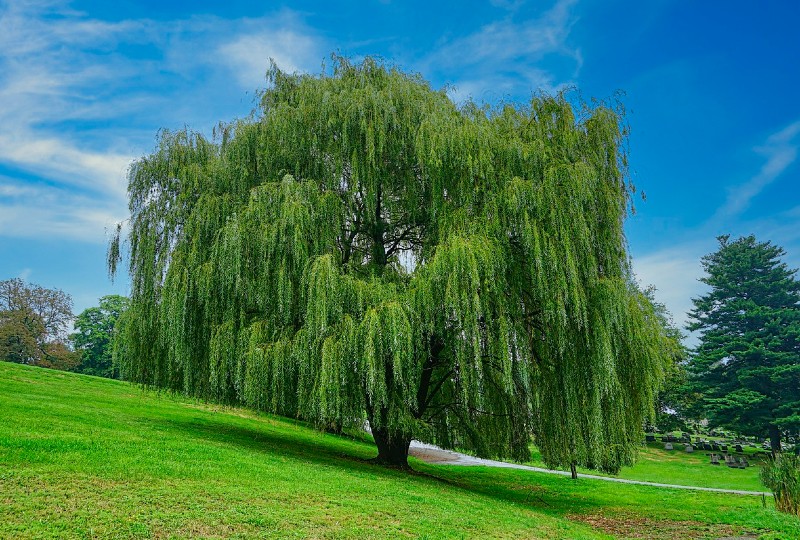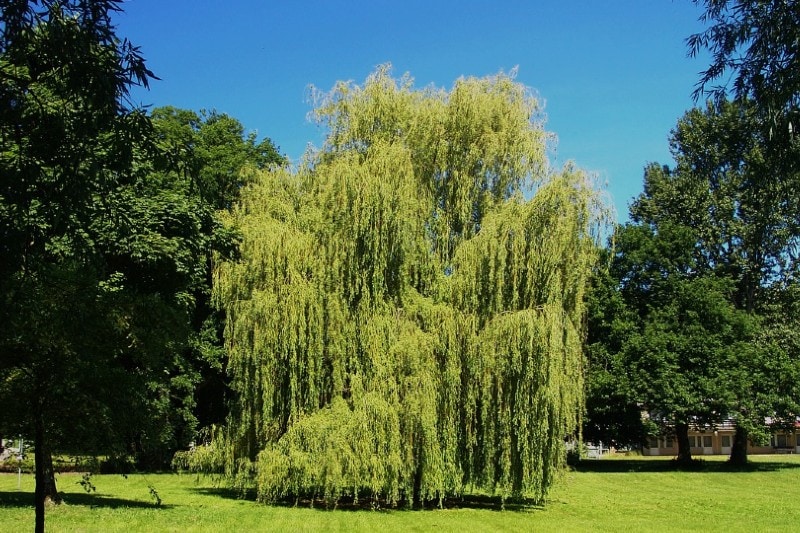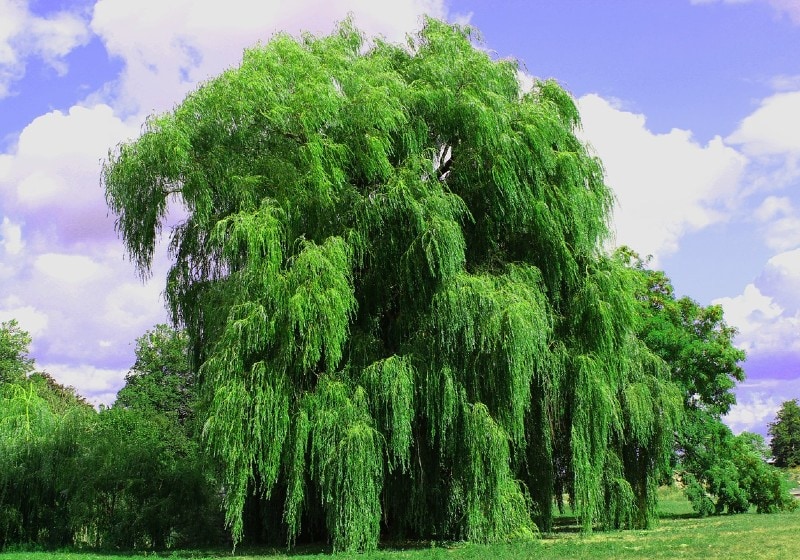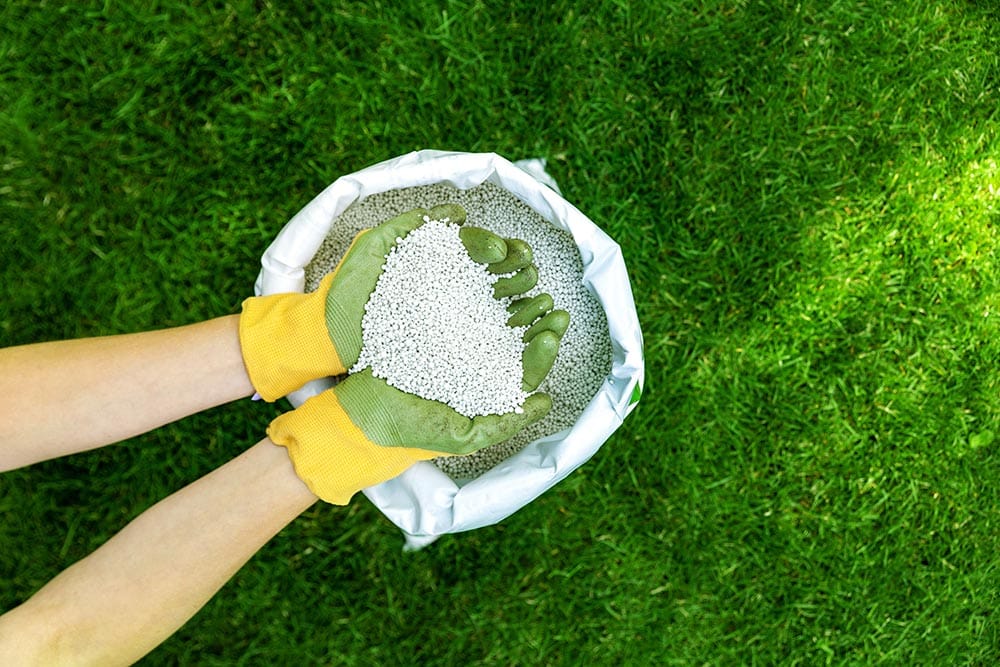How Fast Do Weeping Willow Trees Grow? Types, Conditions & Tips
-
Pete Ortiz
- Last updated:

The low-hanging, elegant branches of the Weeping Willow tree look magical in any garden. They have an element of charm and inspire stories of fantasy and mystery. Not only do they beautify a landscape, but they provide shade and shelter for birds and wildlife.
Although it requires moderate maintenance, it is an attractive tree if planted in the right location, which is usually near large bodies of water. It is one of the fastest-growing trees with 3 – 4ft per year, reaching a maximum height of between 30 and 50 feet. They have a lifespan of 30 to 50 years and can grow up to 24 inches in one year.
What is the Growth Rate of a Weeping Willow?
Weeping Willows are fast-growing trees, especially when they’re in their optimal conditions. They can grow on average up to 3 to 4 feet per year. A young tree takes about 3 years to establish itself, after which it can quickly grow 8 feet per year. It can add 24 inches or more of its height in a growing season. It measures 30 to 50 feet in height and can reach its full growth as soon as 15 years. Weeping Willows have a lifespan of 30 years, but if given the proper care, they can live up to 50 years.

Types of Weeping Willow Trees
- Golden Weeping Willow: This tree has green leaves that turn gold in the fall. It is also fast-growing and can reach 30 feet in 10 years.
- Thurlow Weeping Willow: This is a pyramidal weeping willow with pendulous, longer branches.
- Wisconsin Weeping willow: A hybrid willow that grows quickly
What Growing Conditions Are Needed for a Weeping Willow?
USDA Hardiness Zones indicate that Weeping Willows thrive in zones 4─10 across most of the country. A Weeping Willow can thrive, grow faster and last longer than its life expectancy when grown in optimal conditions.
- Weeping Willows tolerate a wide range of soil conditions but prefer moist, slightly acidic soils that drain well.
- For the first year after planting, a Weeping Willow will need to be watered weekly; thereafter, the soil just needs to remain moist.
- Weeping willow trees thrive in full to partial sun, which means they require at least 4 hours of direct, unfiltered sunlight per day.
- Weeping willows do not require fertilizer to grow healthy and durable.
- Weeping willows are drought tolerant and can withstand winter cold. The tree can also tolerate summer desert heat as long as greenery and water are not too far away.
- When a Weeping Willow is young, it should be pruned so that there is only one central leader for the best growth. Snipping back all branches in late winter or early spring is recommended because it promotes new branch growth and energizes your tree.
- Fungi, powdery mildew, root rot, willow scab, willow blight, and black canker can affect weeping willows, and aphids, borers, and gypsy moths may be a pest issue. This problem can be alleviated with targeted spraying.
How to Grow a Willow Tree?
A standard method for growing Willow Trees is planting a bare root tree at least one year old. Before planting, soak the roots in a bucket of water and work the soil to twice the depth and diameter of the root spread. When planting, pack the soil around the roots and water them well.
Willow trees can also be grown by cuttings. You can take a cutting from an 18-inch long live terminal branch and insert the cut end into the garden or a pot of soil. The soil must be moist, and there must be adequate drainage.

How Can I Increase the Growth Rate of a Weeping Willow?
If you have planted or are planning on adding a Weeping Willow to your landscape, here are some tips to help your tree grow faster.
Grow Your Weeping Willow Near Water
Weeping Willows thrive best near large bodies of water and grow faster and better in standing water. This is usually why you will see them growing on riverbanks and bordering ponds or lakes. Weeping Willows thrive in waterlogged areas because their extensive root system will absorb all the extra moisture. They’re beneficial because they transform an unusable swampy area into fertile land.
If your Willow is not planted near a body of water or in an area that doesn’t drain properly, you should water it weekly in its first year to boost it. Continue watering after a year to keep promoting its growth.
Don’t Skip the Pruning
Pruning is the best way to maintain your Weeping Willow. Pruning removes dead and dying branches which will fend off pest infestation while also promoting growth. Pruning will help your tree grow 3 to 4 feet in a year, which is almost double its usual growth rate. The best time for pruning is late fall or early spring before it blooms.
Pruning your Willow while it is still young will help it develop a strong trunk. Remove any large shoots that sprout near the base or from the tree’s original trunk to form a strong central trunk instead of several branches in the center of the tree.
The suckers at the base of the tree should also be pruned. Rip the suckers away so the fibers are destroyed to prevent them from growing back.
Say Goodbye to Pests and Disease
Pests and disease will not only slow down your willow’s growth rate but could also kill it. Your tree will proliferate if you can deter pests and diseases.
During a particularly wet spring, a willow tree’s newly formed leaves and twigs may quickly turn brown. On the surface of the scar tissue growing in this area, olive-colored spores will form, known as willow tree blight. Applying a fungicide to the tree, mainly the foliage, is the best way to deal with this. You can also prune the branches in the early winter while the tree is dormant or in early spring to prevent it from spreading.
Soil
Weeping Willows thrive in moist, well-draining, slightly acidic soils. If your soil is too alkaline, you can make it more acidic by amending it with sulfur.
Fertilizer
A weeping willow requires a balanced fertilizer with an equal ratio of nitrogen, phosphorus, and potassium, such as a 20-20-20 formula. Nitrogen promotes foliage growth on the tree’s branches, while phosphorus promotes root, stem, and flower growth.

Interesting Facts About Weeping Willows
- Native Americans used willow tree branches to make paintbrushes, arrow shafts, dolls, and dream catchers.
- Willows can also extract dye, which can be used to tan leather.
- Willow bark is used to make flutes and whistles in Norway and Northern Europe.
- Hippocrates, a physician who lived in ancient Greece in the fifth century B.C., discovered that chewing willow bark could reduce fever and pain.
- The healing properties of willow bark were discovered by Native Americans, who used it to treat fever, arthritis, headaches, and toothaches. The willow was known as the “toothache tree” by some tribes.
Conclusion
Weeping Willow trees are one of the fastest-growing trees on the planet, growing up to 24 inches in one year and reaching a height of 30─50 feet. They have a lifespan of about 30 years, but if they are cared for well, they can live for up to 50 years. There are a few simple tips you can follow to boost the growth of your Weeping Willow, and in the right conditions, you will have a magnificent tree adorning your landscape.
- https://www.fast-growing-trees.com/pages/weeping-willow-facts-9-common-questions-answered
- https://homeguides.sfgate.com/weeping-willow-growth-rate-77560.html
- https://gardenersyards.com/how-to-make-weeping-willow-tree-grow-faster/
- https://www.thisoldhouse.com/gardening/reviews/weeping-willow#:~:text=Planting,willows%20have%20very%20long%20roots
Featured Image Credit: daledbet, Pixabay
Contents



